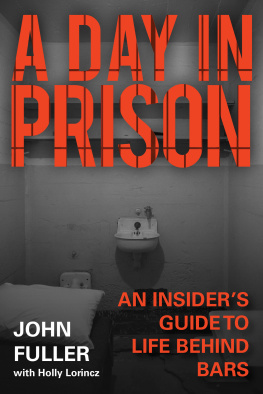Copyright 2017 by John Fuller
All rights reserved. No part of this book may be reproduced in any manner without the express written consent of the publisher, except in the case of brief excerpts in critical reviews or articles. All inquiries should be addressed to Skyhorse Publishing, 307 West 36th Street, 11th Floor, New York, NY 10018.
Skyhorse Publishing books may be purchased in bulk at special discounts for sales promotion, corporate gifts, fund-raising, or educational purposes. Special editions can also be created to specifications. For details, contact the Special Sales Department, Skyhorse Publishing, 307 West 36th Street, 11th Floor, New York, NY 10018 or .
Skyhorse and Skyhorse Publishing are registered trademarks of Skyhorse Publishing, Inc., a Delaware corporation.
Visit our website at www.skyhorsepublishing.com.
10 9 8 7 6 5 4 3 2 1
Library of Congress Cataloging-in-Publication Data is available on file.
Cover design by Rain Saukas
Print ISBN: 978-1-5107-1780-0
Ebook ISBN: 978-1-5107-1782-4
Printed in the United States of America
NOTE:
This books information applies to both male and female inmates, but since less than 10 percent of federal prisoners are women, the examples tend to be male and the pronouns are masculine.
Contents
Privacy, bunks, toilet, hygiene, morning exercise, Ten-Minute Move, trust |
Lines, eye contact, body language, seating arrangements, table manners, managing diseases, weight, the guards, fighting |
Personal space, protecting self, towels, infections, clothes, theft |
Work ethic, Unicor, side hustles, killing time, jobs, outside training |
Physical and mental health, strength, weight room, gangs, defense |
Contact rules, visitation rooms, gifts, eavesdropping, betrayal |
Grief, using time, managing addictions, religion, patience, suicide prevention |
Accounts, useful items, stamps, weapons |
Bartering, drugs, gambling, tattoos, TV, computers, library, snitching |
Meditation, reading, praying, crying, quiet, sleep |
Safety and education |
Self-surrendering, children, money, contact, coming home |
Good conduct time, disciplinary sanctions, parole board |
Introduction
E VERYONE SHOULD UNDERSTAND the brutal reality of living behind bars. According to the Bureau of Justice Statistics, one in every two hundred Americans is sent to prison. With these kinds of numbers, it may not be you going to jail, but theres a good chance you know someone who has been incarcerated, or hes on his way there. This person may even be a white-collar criminal or suburban drug dealersomeone whos never spent time on the street. Unfortunately, the culture on the inside is an intensified version of the culture prevalent in our nations most chaotic and violent neighborhoods. Office rules dont apply. The snapping of fingers to get your coffee is behind you. Nor do soccer-mom rules apply. No one is going to politely listen if you kvetch and complain. You may be a Master of the Universe in your nine-to-five world, but that just puts you more at risk on the inside, where the cell blocks are run by men and women who deal only in respecta respect maintained through violence.
FROM A PAST INMATE
Unfortunately, I spent eleven years in high, medium, and low security institutions around the country, so I know all too well of which I speak. I had to learn the ropes the very hard way.
A reporter from Loaded Magazine once asked what it was like when I first went in. I was honest and told him that I tried to beat the system, thought I was bigger and better than the others. I tried to do things my own way. I let anger rule me. For a while, I ran with a group of other inmates, violent guys, many of whom were known for going around and stabbing other inmates. The fights were dangerous. And all the fighting got me kicked out of numerous prisons. Finally, I realized that when I stopped trying to buck the rules, when I let myself just be a cog, my time was easier.
While on the inside, I saw too many men unwilling to conform to the prison culture, drowning in rage, or unable to withstand depression; almost a third of the deaths in prison are attributed to suicide. Others, like me, resorted to violence, often irrationally. Obeying the institutionalized inmate rules, and my own advice, can possibly save your lifebut only if you are willing to abandon the belief that you are tougher, wealthier, smarter, or more privileged than your fellow inmates. The street-level hustlers and gangbangers (who, on the outside, were snubbed by the rich and middle class driving their luxury cars into gated communities) are now respected, feared, and admired as leaders; their thirst for confrontation, intimidation, and violence permeates the air. They run the show, no questions asked. Dont be fooled: you can be seriously injured or killed for breaking a rule you dont even realize exists, much less refusing to show respect.
The environment inside jails and prisons varies according to the security levels (low, medium, or high security institutions). The culture of the inmates who have an influence in these facilities, and the staff members who run them, will also differ. But once you get a grasp for the basic rules by which prison culture operates, you should be able to adapt the suggestions in this book as needed, whether in a county jail or a high security prison.
But there is one more thing to consider
A DAY IN PRISON FEELS LIKE A LIFETIME
Standing in line. Staring at a wall. Sitting in a cell. Wishing for a visit. Waiting for a letter. Wanting a caress from a loved one.
Tick Tock.
Tick Tock.
Tick Tock.
A minute drags by like an hour. That hour drags by like a day. If youre behind bars, facing a ten-year sentence well, time is your enemy. Abiding by the rules will help you survive, but patience is something just as important. Einstein claimed time passes quickly when sitting with a pretty girl, but minutes slow to what feels like hours when you are in painor bored. If youre headed off to jail, youre about to prove Einsteins theory of relativity to yourself.
In order to come out of this on the other side as a whole and sane person, pay attention, keep your guard up, and start breathing deeplyinhaling calm and exhaling the rage. You cant force the guards to open the doors, the lines to move forward, the second hand on the clock to move any faster you can only control your response. That response needs to be based on patience or you will go crazy.
It will help to know whats ahead of you. On the following pages, you will find chapters devoted to breaking down a typical day in your average prison, offering stories, advice, and rules that correlate to the activities appropriate to that time of day. Its important to realize the hourly breakdown is figurative, since every prison is different and, frankly, daily schedules can be changed at any time, thanks to lockdowns and head counts. But the basic elements dont change, like waking up in a cell, going to the cafeteria, taking a shower, etc. (only the scheduled times vary from prison to prison), so you will easily be able to take the information and apply it to your own particular situation or schedule.














